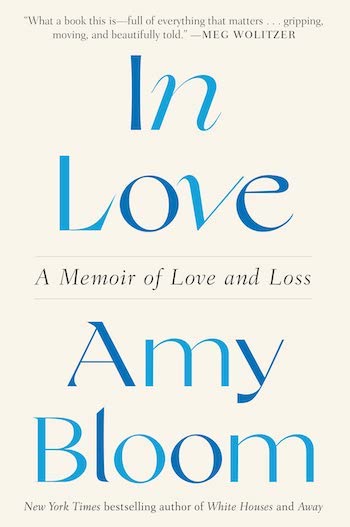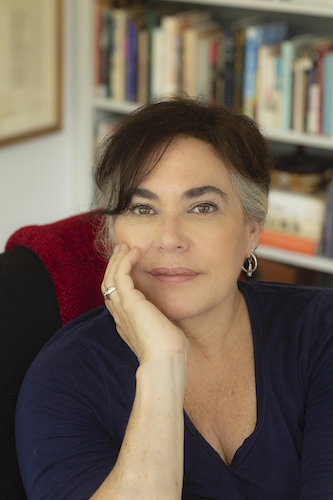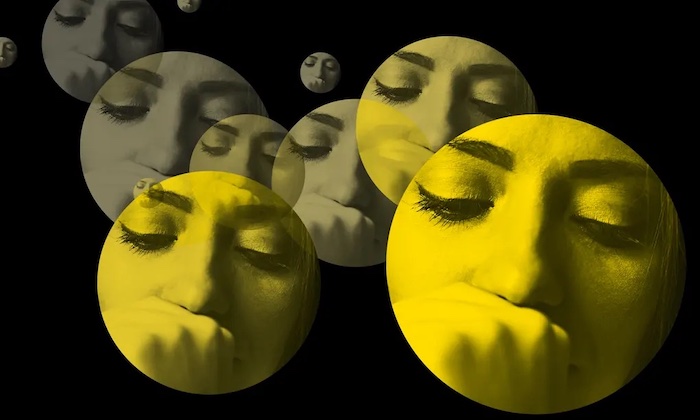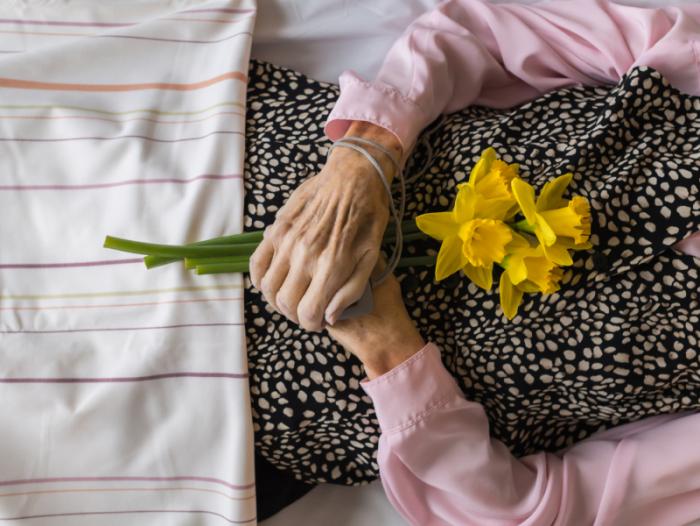
By Helen Epstein
Even readers familiar with novelist Amy Bloom’s conversational, ironic, sometimes elliptical style and her unconventional choices of subject matter may be jarred by the subject of her new memoir – an account of the assisted, aka accompanied, suicide of her 66-year-old husband Brian Amiche.
Over the past decades, there have been many books — fiction and nonfiction — by writers who have decided to end their own lives (usually by the legal means of voluntarily refusing to eat or drink) or writers who have assisted others, but assisted suicide is still a dangerous literary subject. Assisting a person to kill themself is considered murder in all American states but California, Colorado, Oregon, Vermont, Montana, New Jersey, Maine, Hawaii, Washington, and the District of Columbia. All require that the potential suicide be a resident, assessed by two physicians as having only six months to live, and able to express the wish to die, orally and in writing to two local physicians.
Apart from the emotional stress of making this decision, on a timetable determined by others, in an environment not helpful to people who wish to end their lives, there is a possibility that relatives and friends, even strangers who find suicide immoral, may take legal action against anyone who enables it. At a time when Right to Lifers in some parts of the U.S. are suing physicians who perform abortions, this is not a minor concern. Even though most of us know someone whose partner has been diagnosed with Alzheimer’s — I currently know four such people — and we hear reports of the long deterioration between diagnoses and deaths from their caretakers, few of us know how the Alzeimer’s patient wants (or once wanted) to end their life. Bloom’s memoir is a rare book that aims to tell us, a memoir as well as a guide.
It begins quietly, on “Sunday, January 26, 2020, Zurich, Switzerland. This trip to Zurich is a new, not quite normal version of something Brian and I love: traveling. Road trip, train ride, ferry ride, airplane anywhere.” Then, after we learn they’re settling down in Business Class en route to Switzerland, the narration swerves. “Dignitas’ office is in Zurich, and that’s where we’re headed. Dignitas is a Swiss nonprofit organization offering accompanied suicide. For the last twenty-two years, Dignitas has been the only place to go if you are an American citizen who wants to die and if you are not certifiably terminally ill with no more than six months to live. This is the current standard in the United States, even in the nine right-to-die states plus the District of Columbia, about which many older or chronically ill Americans harbor end-of-life fantasies and which I researched, at Brian’s direction, until we discovered that the only place in the world for painless, peaceful, and legal suicide is Dignitas, in the suburbs of Zurich.”
In August of 2019, two months after he turned 66, Brian Ameche, oldest son of a large Italian-Catholic family, architect, fisherman, and Yale football hero, was definitively diagnosed with Alzheimer’s. Bloom, whom he married in 2007, had suspected that something had been affecting his behavior since 2016. Now, after an MRI and a second neurology consult, that something is diagnosed as Alzheimer’s disease. In Bloom’s account, “It took Brian less than a week to decide that the ‘long good-bye’ of Alzheimer’s was not for him” and less than a week for Bloom to find Dignitas, after he asked her to research and organize a good death. The epigraph to this book is: “Please write about this,’ my husband said.”
In Love: A Memoir of Love and Loss is a testament to the tortuous process of devising a good death in the United States in the 21st century, and going through with it. Bloom takes the reader through the stages, from her first observations of her husband’s changes that she ascribes to middle-age: forgetting names, repeating questions, a new irritability, new likes and dislikes, his handwriting, appointments and medications confused, inexplicable problems at work. Then being fired from a job for which he had recently been enthusiastically hired to more obvious signs of illness. By 2016 — only nine years into their marriage — she has become more alarmed and begins to research the differences between mild cognitive impairment and true Alzheimer’s disease on websites and videos. But along with worrying and calculating her partner’s probable timetable, she is still “minimizing” and “normalizing” and keeping her real thoughts secret from almost everyone she knows.
One of the attractions of Bloom’s fiction is her psychological insight. She was a psychotherapist before she became an author and she tells this story as clearly as a case history yet in a voice as seductive as her best fiction. Her account of how she and Ameche met might be mistaken for one of her short stories: “September 2005, Durham, Connecticut….Brian and I fell in love the way some middle-aged people in unhappy partnerships and in small towns do: liberal Democrats in a Republican town, ethnic types in a town full of Northern Europeans, opinionated loudmouths… He said, What’s your family like? I said Jews, from New York. You? He said, Well we’re a football family. We have three Heisman trophies in my family. I said, What’s a Heisman, and he kissed me. I kissed him back and, sensibly, we avoided each other for the next year.”
Understatement, wit, and light irony — rather than depth — are features of Bloom’s fiction and they are in evidence in this memoir too. Anchored in short chapters over a period of the five key days around Zurich, In Love flashes forward and back over scenes from their marriage and as well as to Ameche’s two memorial services, the first in the library across the street from their Connecticut home and a second in a Unitarian Universalist church in Philadelphia, the Ameche family hub. Bloom tells us little about how this event has been arranged but hints that as a Catholic suicide married to a Jew, and an activist for Planned Parenthood, who has personally escorted women past protestors at abortion clinics, he is not the best candidate for a Catholic burial.
Bloom paraphrases almost every conversation she has with her husband so that everything that happens is rendered in her voice. Though it is an eminently readable voice and I inferred that avoiding direct quotes was a defense against potential legal action, I found myself wanting to hear him speak about the reasoning that led to his decision to end his life before he no longer was able to do so.
Bloom quotes only one of their actual conversations.
“Here’s my first choice,” Brian says. “We go through this process and whenever it is that we reach the point that it seems like I’m really going downhill, you tell me and then we lie down together maybe in my office, not in our bedroom — well maybe in our bedroom, we’ll see — and you give me whatever will kill me. I trust your judgment.
“I can’t do that darling. It’ll be murder. I can’t give you something that will kill you. We read about that all the time. These people can be prosecuted,” I say, although I don’t really think that a white woman my age will be sent to do hard time for assisting her husband in ending his life, in Connecticut, the Land of Steady Habits, as Brian calls it.
“I could go to jail.”
Instead, Bloom goes online, on a computer in the public library, also, I assume, for legal reasons. After scrolling through the many ways people in the 21st century choose to kill themselves, she comes upon Dignitas, the Swiss organization that has “served” 3000 people who have successfully completed a gauntlet of stringent protocols and paid a $10,000 fee.
There are few supporting characters that are more than a sketch in this memoir and the reader craves to know more about them: their Dignitas contact who works under the alias of “Heidi” and Dr. G., their doctor in Zurich; her older sister Ellen, who gives Bloom a check to finance the trip to Dignitas; Bloom’s adult children and grandchildren; her Tarot card reader and her psychiatrist; his meditation leader and his therapist. Some key characters are described as “friend of a friend” or “a woman who knew a woman.” These shadow figures are meant to evoke the furtive days of abortion pre-Roe vs. Wade. But none of the supporting cast are fleshed out or extensively quoted, with the exception of the Clinical Director of End of Life Choices New York, Dr. Judith Schwartz, whose job it is to dispense such information, who vouches for Dignitas, and advises Bloom on how best to interact with the organization (“Just do what they tell you,” she says).
“I love Judith Schwartz,” Bloom writes, “as I now love everyone I speak to who is not cruel, horrified, or utterly useless in this process.”
Most surprisingly, it is Brian’s mother, Yvonne Ameche, who is living through the awful Alzheimer’s-driven deterioration of her closest friend, who becomes a steady and generous support. Mrs. Ameche is the only member of the Ameche family whom Bloom portrays in any detail and I welcomed reading everything about her reaction to their decision. Bloom also provides a sketch of her psychotherapist Wayne, who in addition to getting Bloom through the ordeal, volunteers to have a 90-minute interview with her husband and provide a medical assessment (required by Dignitas) attesting to the absence of any clinical depression in Ameche.
In this letter that Bloom excerpts for nearly two pages we finally get a biographical sketch of the man from someone other than the author: “He is the oldest of six children of a legendary American football hero and his loving but limited wife. He himself was an outstanding football player at Yale University, where he also began his architectural studies. He married his teenage childhood sweetheart. This was a union that did not stand the test of maturity that comes with life. They divorced without children. The divorce caused upheaval in Mr. Ameche’s devout Italian-American Catholic family of origin…Mr. Ameche estimates that he has 60-80 percent of his recent memory capacity left. I would estimate that it is more like 40-50 percent…At the moment he is mentally competent with sound judgment that is unhampered by mental illness or severe character disorder….”

Close to the end of the book, on January 30, 2020, Bloom takes us to the apartment in an industrial park outside Zurich where Dignitas ends its clients’ lives. Here, she retraces, step by step, the Swiss-sanctioned end-of life ritual, describing the two tactful and neatly dressed ladies who greet them, the large room with many bowls of chocolate and several places to sit or lie down, the last conversation she and her husband have. He drinks his anti-emetic, then the sodium pentobarbital. He falls asleep. He stops breathing. Bloom sits with him alone for a while; then the ladies return to usher her out before the Swiss police arrive to identify the body. Then, she takes an Uber to the airport.
As it happened, I had just read a co-authored memoir of a couple that had pursued assisted suicide in California and documented a very different process in alternating chapters: his and hers. In A Matter of Life and Death, Marilyn Yalom is terminally ill, not with Alzheimer’s but with multiple myeloma, a lethal form of cancer diagnosed in 2019. She suffers from debilitating physical symptoms but her cognitive powers remain intact. Long married to psychiatrist and eminent novelist Irwin Yalom, both she and her husband are in their 80s and long-time California residents, able to make use of the state’s end-of-life laws.
They, too, are accomplished writers. Marilyn Yalom, was a professor of literature and women’s studies and their memoir, like In Love, was a project she, the dying party, initiated as a document, a how-to for others in similar circumstances and, one suspects, a memorial book for her family. Written in alternating chapters that take us from diagnosis and a hospice to a physician-assisted death, the reader is told the story from both partners’ points of view, one account often serving as a reality check on the other. It also provides a rich context filled with doctors, colleagues, children,and grandchildren. It is careful, comprehensive, and occasionally plodding. But, alternating chapter by chapter, it leaves no questions unanswered for the reader.
Bloom’s book, on the other hand, does. It is a memoir with all the strengths and limitations of the form and the single point of view of the memoirist. I was always aware of her selection of what to include and what to leave out. She leaves out their relative ages: will she be an old or young widow? (Wikipedia notes that they are the same age, both born in 1953). She does not write about anyone who contested or refused to comply with their plan or questioned their reasons. The people she does portray at any length are extraordinarily supportive and helpful. None express any doubts about Brian Ameche’s decision and the reader doesn’t know whether they expressed any or how many people even know about it because Bloom chooses to be vague about whom the couple told and when.
It is extraordinary for anyone to share the details of so intimate and controversial a process as assisted suicide with the world and I feel petty and picky quibbling with Bloom’s choices. But I wondered: did anyone say to her, don’t do it? Did any of Ameche’s friends or family express doubts? I would have liked to read much more direct dialogue. I would have liked to know about Brian Ameche’s life history, his life trajectory, his friends, recollections of members of his book group, his relations with his family of origin, his previous marriage, and the beliefs that allowed him to decide, in Bloom’s paraphrase, that he’d rather die on his feet than live on his knees.
Bloom’s voice is so strong and authoritative that I also missed other voices for contrast. Perhaps few people were willing to be quoted about Ameche himself or his decision to pursue assisted suicide. But this omission makes Bloom the sole authority, which gives In Love an unequivocal quality that made me, at times, question her version of the story. Yet with this caveat I found In Love a beautifully written and profoundly disturbing memoir about a subject that hits close to home for many readers. It is a heart-rending book and a very brave one.
Complete Article ↪HERE↩!







